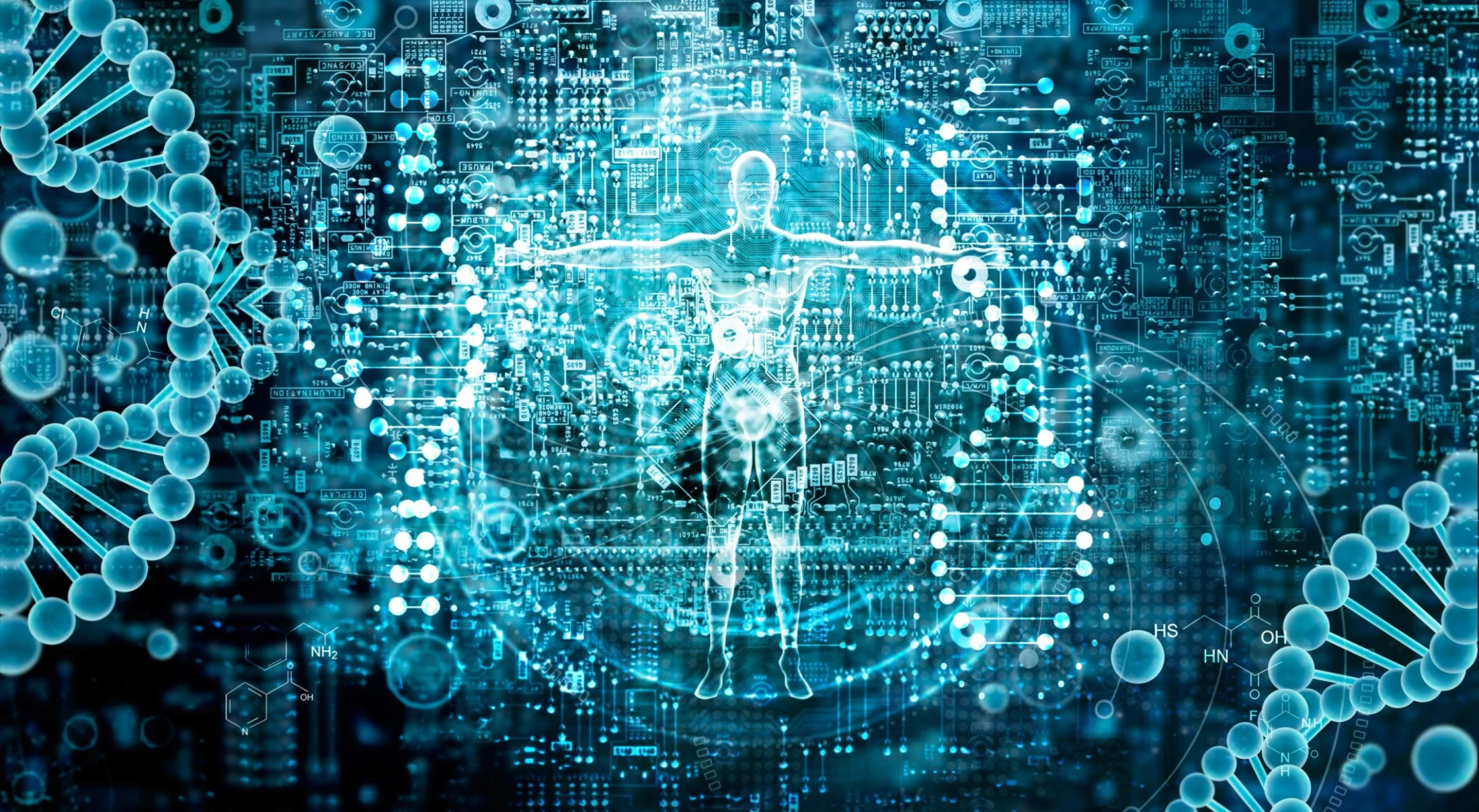AI Chatbots in Healthcare: Conversational Cure for Your Business


AI chatbots like ChatGPT and Bard keep stealing the tech spotlight. They simulate human activities, helping people search for information and perform actions, which many healthcare organizations find useful.
47.5% of the healthcare companies in the US already use AI in their processes, saving 5-10% of spending.
AI-driven chatbots are a new trend in the industry. Discover what they are in healthcare and their game-changing potential for business. Also, check real-world use cases and the AI chatbot development guide.
AI chatbots in healthcare
AI-powered medical chatbots have been one of the year’s top topics, with ChatGPT, Bard, and other conversational agents taking center stage. For healthcare businesses, the adoption of virtual healthcare assistants may become a strategic advantage.
Google is working on training its chatbot in various healthcare facilities, including the Mayo Clinic. Microsoft is also developing a medical chatbot using OpenAI’s ChatGPT in collaboration with Epic.
An artificial intelligence medical chatbot is a form of computer software. It can decipher human language and engage in conversations with people. Such an interactive AI technology can automate various healthcare-related activities. A medical bot is created with the help of machine learning and large language models (LLMs).
The foremost chatbot applications in healthcare and the tasks they help automate in the healthcare industry include:
- Appointment scheduling
retrieves information about available slots, doctors, and schedules. It helps to pick the best spots for each patient individually and submits appointment information to a system automatically.
- Symptoms assessment
assesses symptoms and provides information on possible diagnoses.
- Prescription refills
notifies patients when it’s time to renew their medications and processes refill requests.
- Patient triage
analyzes the symptoms of patients and categorizes them by severity, prioritizing urgent cases.
- Mental health support
provides therapy, following rules and strategies for mental health conditions treatment.
- Billing and claims automation
verifies insurance coverage and assists with filing claims.
- Data analysis
translates requests submitted in natural language into SQL code for retrieving and analyzing data.
- Knowledge base retrieval
provides answers to users’ questions, using data from a knowledge base. Helps find defined guidelines and instructions.
- Information summarization
provides concise answers and summarized information about clinical research, internal documents, patient analytics, etc.
AI Chatbots Success in Numbers
As per statistics, the healthcare chatbot market size is expected to grow steadily at a CAGR of 16.98%.
AI healthcare chatbots have been incorporated into daily practice and workflows by 35% of organizations in the industry. The top business results achieved by top providers are as follows.
- SWICA—124% increase in leads capturing; over 80% accuracy in diagnosis.
- Lupin—92% satisfaction rate in correct and contextual content delivery.
- Zydus Hospital—88,000+ conversations and 5,527 appointments booked by the chatbot.
- Humana—7,000+ voice calls handled daily by the chatbot. Also, it collects and summarizes the feedback.
- Cigna Corporation—1,000+ customer inquiries resolved within a week; 3X faster response time.
- GSK—Interacted with 7,000+ individual users, responding to a total of 83,000 inquiries.
Build a custom AI chatbot?

Business First
Code Next
Let’s talk
Chatbot use cases in healthcare (examples included)
If you want your company to benefit financially from AI solutions, knowing the main AI chatbot use cases is the key.
A use case is a specific AI chatbot usage scenario with defined input data, flow, and outcomes. An AI-driven chatbot can identify use cases by understanding users’ intent from their requests. Use cases should be defined in advance, involving business analysts and software engineers.
AI chatbots in the healthcare industry are great at automating everyday responsibilities in the healthcare setting. They can do so by processing large data volumes and matching patterns.
The six most popular use cases of AI chatbots in healthcare are as follows.
1. Appointment Scheduling
Healthcare chatbots with access to medical databases retrieve information on doctors, available slots, doctor schedules, etc. Patients can manage appointments, find healthcare providers, and get reminders through mobile calendars. This way, appointment-scheduling medical chatbots in the healthcare industry streamline communication and scheduling processes.
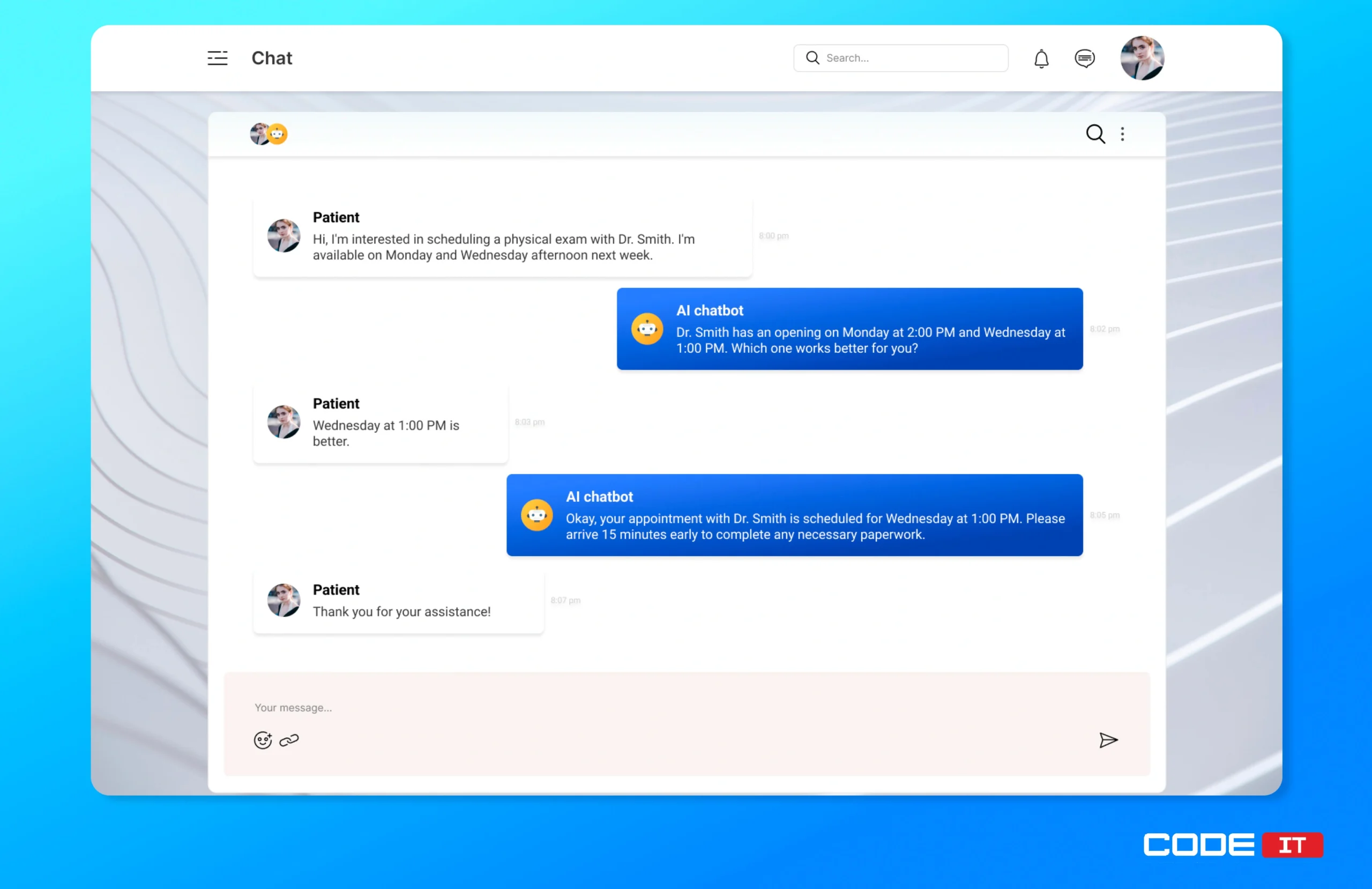
If you’re interested in building an appointment-scheduling bot, stay tuned. We’ll delve deeper into the medical chatbot development breakdown.
Business value: Maximized clinic revenue and optimized appointment scheduling for increased patient throughput.
2. Symptoms Assessment
A conversational bot can examine the patient’s symptoms and offer potential diagnoses. This also helps medical professionals stay updated about any changes in patient symptoms. This bodes well for patients with long-term illnesses like diabetes or heart disease symptoms.
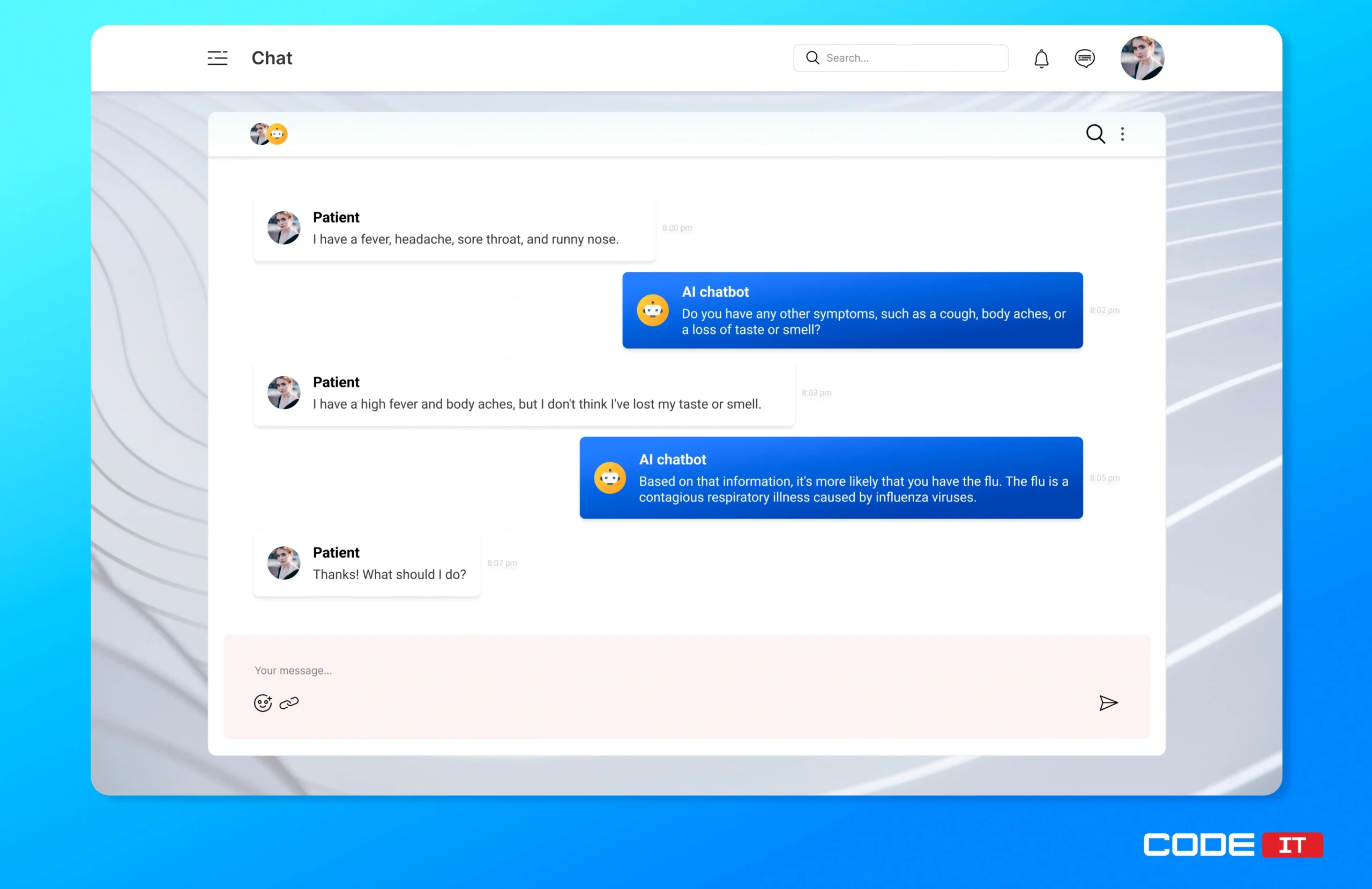
ChatGPT has demonstrated a diagnostic accuracy of 90% for medical conditions. They include pneumonia, urinary tract infections, and asthma. It proved the LLM’s effectiveness in precise diagnosis and appropriate treatment recommendations.
Business value: Enhanced operational efficiency and minimized staff involvement for scalable healthcare delivery.
3. Prescription Refills & Reminders
Chatbots can collect user data: name, contact details, patient’s medical history, or visit dates. The technology can use this data for personalized, timely reminders. A medical bot can notify users when it’s time to renew their medicines, improving drug compliance. The system asks the doctor for a final decision and tells the user when it’s time for a prescription refill.
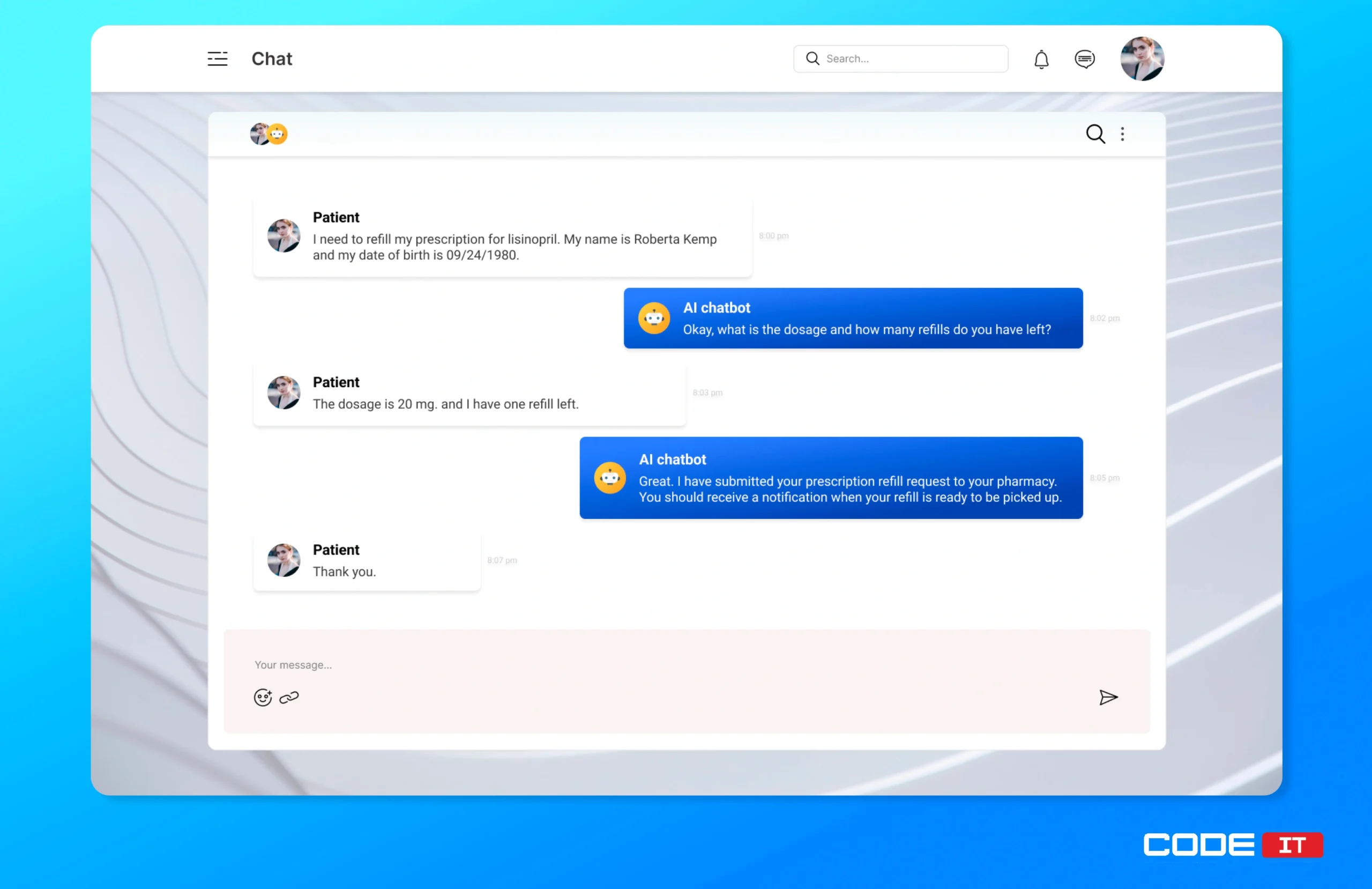
Such a streamlined prescription refill process is great for cases when a clinician’s intervention isn’t required. More advanced AI algorithms can even interpret the purpose of the prescription renewal request. This prevents medication errors and eases the load for clinicians.
Business value: Enhanced overall service quality through the automation of time-consuming and repeated processes.
4. Patient Triage
Healthcare professionals can now efficiently manage resources and prioritize clinical cases using artificial intelligence healthcare chatbots. The technology helps clinicians categorize patients depending on how severe their conditions are. A medical bot assesses users through questions to define patients who require urgent treatment. It then guides those with the most severe symptoms to seek responsible doctors or medical specialists.
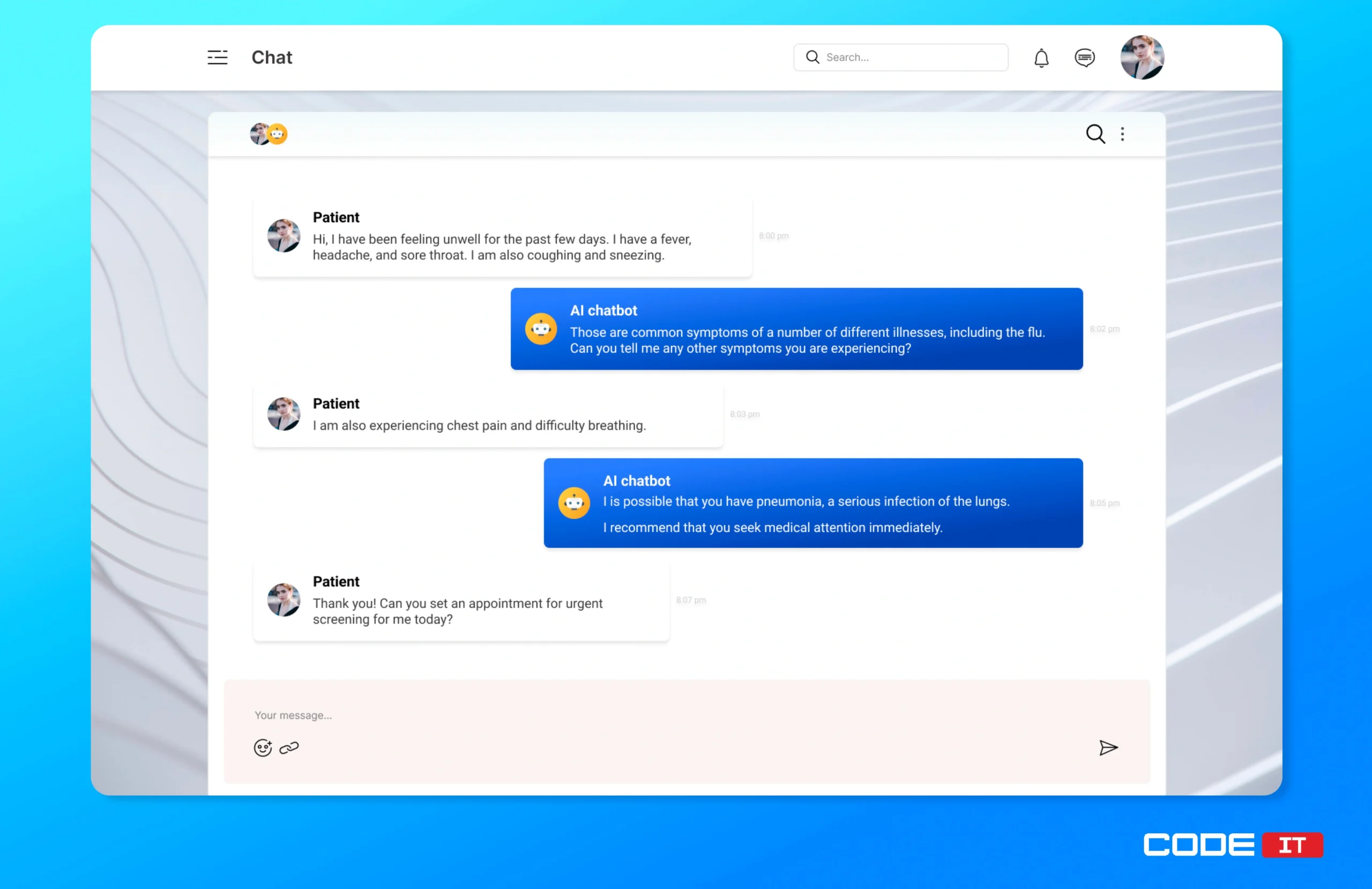
This application of triage chatbots was handy during the spread of coronavirus. AI text bots helped detect and guide high-risk individuals toward self-isolation. The technology helped the University Hospitals system used by healthcare providers to screen 29,000 employees for COVID-19 symptoms daily. This enabled swift response to potential cases and eased the burden on clinicians.
Business value: Better crisis response and resource allocation efficiency.
5. Mental Health Support
Medical chatbots in the healthcare industry provide support by recommending coping strategies for various mental health problems. They include depression, anxiety, or post-traumatic stress disorder (PTSD). A bot may also refer users to healthcare professionals.
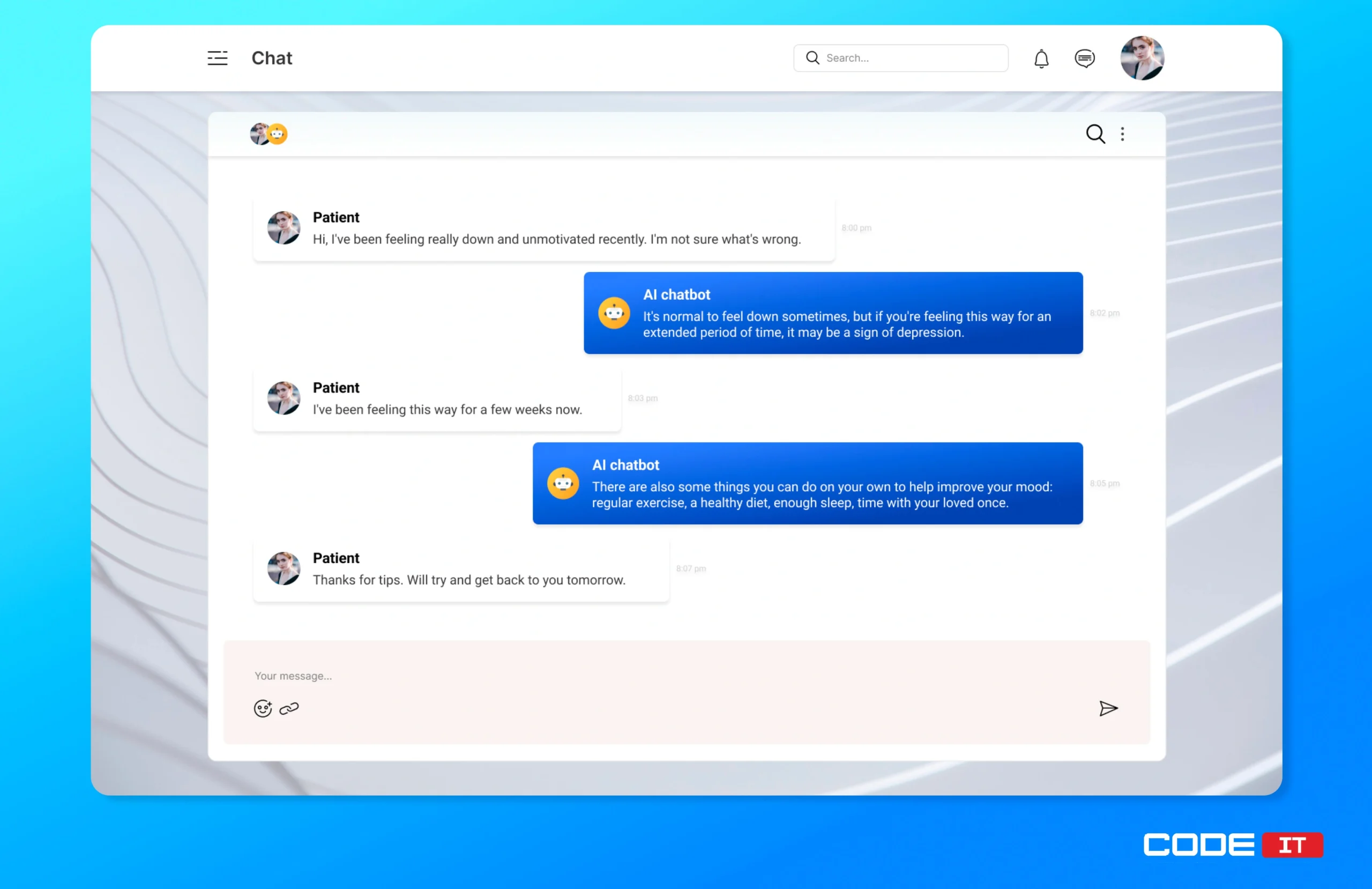
Some bots can provide cognitive behavioral therapy (CBT). Others may help autistic individuals enhance social and job interview skills. Patients can use text, microphones, or cameras to get mental health assistance to engage with a clinical chatbot.
Business value: Expanded mental health service reach and augmented patient care offerings.
6. Billing, Coverage, and Claims Automation
Healthcare providers can handle medical bills, insurance dealings, and claims automatically using AI-powered chatbots. They can verify coverage and assist in filing and tracking claims. Chatbots also support doctors in managing charges and the pre-authorization process.

The Physician Compensation Report states that, on average, doctors have to dedicate 15.5 hours weekly to paperwork and administrative tasks. With this in mind, customized AI healthcare chatbots are becoming a necessity for today’s healthcare businesses. The technology takes on the routine work, allowing physicians to focus more on severe medical cases.
Business value: Increased performance and improved service quality in insurance and claims processing.
How AI chatbots work
In primary care, messaging bots serve as the first point of contact. They assist users in identifying symptoms and guide individuals to seek professional medical advice if needed.
Let’s check how an AI-driven chatbot in the healthcare industry works by exploring its architecture in more detail.
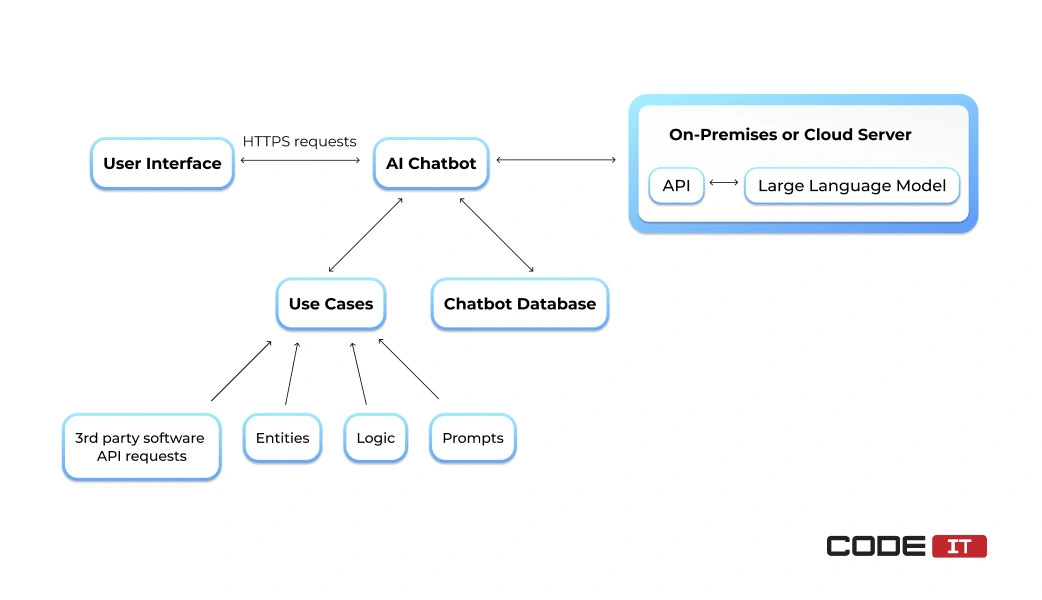
The core components of an AI chatbot in healthcare are:
- User interface.
A distinctive web, mobile, or desktop application that enables access to a chatbot. An integration with an existing messaging app can be used as well.
- AI chatbot.
The core component that accepts and processes user requests and provides responses.
- Chatbot database.
A dedicated data repository can be used to store user data or as a knowledge base.
- Use cases.
A set of defined operations that an AI chatbot can perform. Every use case has a purpose—to gather data about available slots, analyze symptoms, provide financial information, etc.
- Large language model.
A dedicated algorithm that uses natural language processing to analyze messages and generate responses.
Chatbots provide rapid access to drug information. This way, healthcare chatbots help medical workers allocate more time to focus on patient care and more important tasks.
Already have a list of requirements? Let’s discuss it

Business First
Code Next
Let’s talk
How to build AI chatbot in five steps
The five core steps of creating a chatbot in the healthcare industry are as follows:
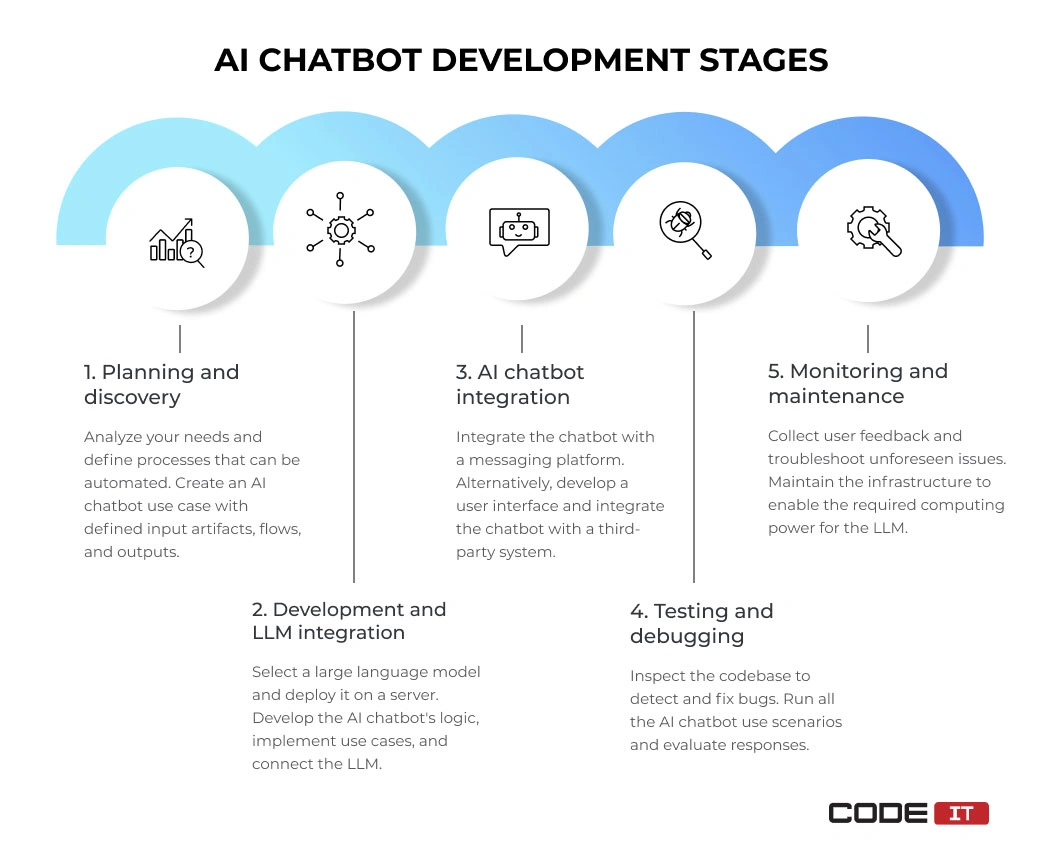
1. Planning and Discovery
Before moving on to the next stages, setting your goals right is essential. Ensure they align with the project requirements and the client’s desired outcomes.
It’s advisable to involve a business analyst to define the most required use cases. Also, they will help you define the flow of every use case, including input artifacts and required third-party software integrations.
2. Development and LLM Integration
Develop the logical flow between the users’ and the chatbot’s lines. Create user interfaces for the chatbot if you plan to use it as a distinctive application.
Software engineers have to develop a chatbot’s logic and implement use cases. Also, they need to configure a database and connect a large language model. An LLM should be deployed on an on-premises or cloud-based server.
Integration with a hospital’s internal systems is required to run administrative tasks like appointment scheduling or prescription refill request processing.
We’ve prepared a comparison table of the most popular LLMs that have inbuilt data protection and can be used for commercial purposes below.
| Name | Number of parameters | On-premise deployment | Multi-language support | Free API access | Comment |
|---|---|---|---|---|---|
| ChatGPT 4 | 1 trillion | No | Yes | No | Supports video and audio. |
| ChatGPT 3.5 | 175 billion | No | Yes | No | Works well without any adjustments. |
| PaLM 2 (Google BARD) | 137 billion | No | Yes | Yes | Accurate responses. Provides a lot of extra and unnecessary info. |
| Falcon 40 | 40 billion | Yes | Limited (can translate only) | Yes | Provides accurate responses. |
| GPT-J | 6 billion | Yes | No | Yes | Needs accurate prompts. |
A thorough research of LLMs is recommended to avoid possible technical issues or lawsuits when implementing a new artificial intelligence chatbot. For example, ChatGPT 4 and ChatGPT 3.5 LLMs are deployed on cloud servers that are located in the US. Hence, per the GDPR law, AI healthcare chatbots in the healthcare industry that use these LLMs are forbidden from being used in the EU.
3. AI Chatbot Integration
It’s recommended to develop an AI chatbot as a distinctive microservice so that it can be easily connected with other software solutions via API.
Software engineers must connect the chatbot to a messaging platform, like Facebook Messenger or Slack. Alternatively, you can develop a custom user interface and integrate an AI into a web, mobile, or desktop app.
4. Testing and Debugging
Perform thorough testing to discover and address any bugs or issues. Quality assurance specialists should evaluate the chatbot’s responses across different scenarios.
5. Monitoring and Maintenance
Gathering user feedback is essential to understand how well your chatbot is performing and whether it meets user demands. Collect information about issues reported by users and send it to software engineers so that they can troubleshoot unforeseen problems.
Also, it’s required to maintain the infrastructure to ensure the large language model has the necessary amount of computing power to process user requests.
Let’s develop a custom AI chatbot tailored to your business needs

Business First
Code Next
Let’s talk
Expert-recommended AI chatbot ideas
With so many algorithms and tools around, knowing the different types of chatbots in healthcare is key. This will help you to choose the right tools or find the right experts to build a chat agent that suits your users’ needs.
Our tech team has prepared five app ideas for different types of AI healthcare chatbots in healthcare.
| AI Chatbot Type | Description |
|---|---|
| General | A custom solution for exploring a wide range of subjects in databases. Ideal for routine symptom screening and linking users to providers or health promotion apps. |
| Specialized | Handles complex questions requiring in-depth research. Suitable for tasks like providing recommendations. |
| Interpersonal | Provides information without forming a close connection. Suitable for applications like imaging diagnostics or hereditary assessments. |
| Intrapersonal | Customized for providing companionship or support. Ideal for apps offering counseling, emotional support, or health promotion, requiring a human touch. |
| Interagent | Designed for interfacing with text bots or other computer systems. Ideal for administrative tasks, especially transferring patient information between locations. |
| Informational | Structured to deliver information sourced from extensive databases. Helps users find resources and supports remote patient monitoring. |
| Conversational | Designed to engage in natural conversations with users. Suitable for applications related to counseling, emotional support, or health promotion. |
| Task-centric | Specialized in executing a single, predetermined task. Suitable for solutions centered around screening and diagnostics. |
| Pattern matching | Deploys pattern matching in scenarios with a narrow domain and sufficient data for AI chat system training. Suitable for applications related to screening and diagnostics. |
| Integration with human assistance | Requires the integration of human computation to enhance flexibility and robustness. Suitable for various applications, except those where speed is critical in delivering care. |
Artificial Intelligence In Healthcare
Top healthcare chatbots in real life
Many providers, hospitals, and organizations have already applied chatbot technology in healthcare. Let’s review the foremost real-life cases of using AI chatbots for medical information.
1. Patient Consultation
The World Health Organization (WHO) has deployed an AI chatbot that provides virtual consultations for users all over the world regarding Covid-19. The chatbot supports 19 languages, supporting millions of people by providing personalized answers to their questions about the disease.
The chatbot has helped reduce the load on healthcare workers during the COVID-19 outbreak by simultaneously handling thousands of diverse chat sessions.
2. Appointment Scheduling
Zydus Hospitals has implemented an AI chatbot that facilitates appointment scheduling, eliminating the need for administrative staff to manage schedules and make appointments. The chatbot analyzes patients’ requests, checks doctors’ schedules, and automatically creates new appointments.
Moreover, the chatbot provides automated notifications to remind you and guide patients in preparing for their visits. The implementation output includes simplified work for hospital management and improved reliability by reducing mistakes.
3. Patient Feedback Collection
Saba Clinics has implemented a chatbot that automates post-conversation feedback collection, analysis, and summarization. The AI assistant is connected to the customer satisfaction system for automated assessment of experiences across various services.
The chatbot asks and clarifies questions, enabling the opportunity to share detailed feedback in a free form using natural language. The collected feedback is analyzed and translated into ratings assigned to defined interactions with healthcare specialists. The integration with business intelligence tools enables the administrative staff to access charts and ratings.
4. Prescription Refill Requests
HealthJoy is an AI assistant that helps patients submit tickets for medication refilling. It gathers all the required information and sends it to a healthcare provider in a defined format. Moreover, it analyzes patients’ demographic information, diseases, and other details. It uses the information to suggest the best-matching recommendations for analysis and healthcare practices.
5. Medication Management
Florence is an online AI assistant that supports patients in managing their medication intake and collecting results. During the communication with the chatbot, patients can submit information about their medication intake schedules in a free form. The AI assistant reminds patients about the need to take their medications.
Moreover, the AI chatbot communicates with patients, collecting information about their symptoms. All the data about health conditions is stored for further analysis of the impact of medication.
6. First Aid Assistance
DocsBot AI is a solution that has been developed for helping users to tackle emergency healthcare issues with expert guidance. It assists users by understanding their emergencies and offering real-time access to medical protocols, guides, and documentation that is useful for providing first aid medical activities in a professional way.
Benefits of chatbots in healthcare
In the United States alone, more than half of healthcare leaders, 56% to be precise, noted that the value brought by AI exceeded their expectations.
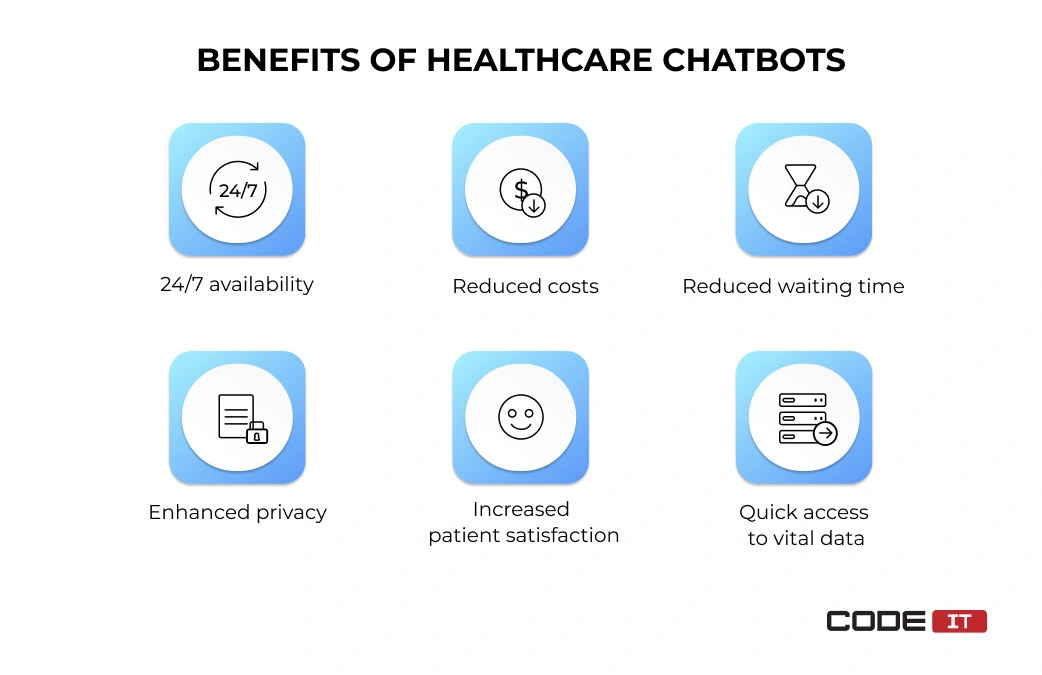
Let’s take a look at some of the main benefits of AI chatbots in healthcare.
1. Chatbot is Available 24/7
Health bots assist patients, ensuring that medical help is available around the clock. As users get instant medical assistance, healthcare chatbots cut long hold times or struggle to fit appointments into their busy schedules.
2. Chatbot Cuts Care-Related Costs
Customized chat technology helps patients avoid unnecessary lab tests or expensive treatments. A chatbot guides patients through the medical system, reducing costs. It does so without compromising the quality of service and medical care.
3. Chatbot Reduces Waiting Time
This AI-driven technology can quickly respond to queries and sometimes even better than humans. A medical bot can recognize when a patient needs urgent help if trained and designed correctly. It can provide immediate attention from a doctor by setting appointments, especially during emergencies.
4. Chatbot Offers Privacy
Healthcare chatbots let you choose advice that’s non-human and non-judgmental. A feature that helps keep your medical information private. This is helpful when patients need to talk about sensitive topics like depression or sexual abuse. A study by Frontiers found that 57.8% of participants were more comfortable consulting AI for these symptoms than talking to a doctor.
5. Chatbot Keeps Your Patients Satisfied
Automation is becoming more prevalent across many industries. More sophisticated algorithms can deliver personalized experiences. In the same way, chatbots learn how to understand patients’ needs better. For example, when a chatbot suggests a suitable recommendation, it makes patients feel genuinely cared for.
6. Chatbot Ensures Quick Access To Vital Details
If you think of a custom chatbot solution, you need one that is easy to use and understand. A text bot can provide important information for its users. This can be anything from nearby facilities or pharmacies for prescription refills to their business hours.
Disadvantages of chatbots in healthcare
AI healthcare chatbots can deliver incorrect or inaccurate responses. In the case of Tessa, a wellness chatbot provided harmful recommendations due to errors in the development stage and poor training data. And this is not a single case when a chatbot technology in healthcare failed.
Case in point, people recently started noticing their conversations with Bard appear in Google’s search results. This means Google started indexing Bard conversations, raising privacy concerns among its users. So, despite the numerous benefits, the chatbot implementation in healthcare comes with inherent risks and challenges.
These are mainly issues with:
- Data privacy and security
- Large language model (LLM) biases
- Errors in the chatbot’s responses
How do we deal with all these issues when developing a clinical chatbot for healthcare? The CodeIT team has solutions to tackle the major text bot drawbacks, perfect for businesses like yours. We adhere to HIPAA and GDPR compliance standards to ensure data security and privacy. Our developers can create any conversational agent you need because that’s what custom healthcare chatbot development is all about.
Access the right expertise to develop an advanced AI chatbot

Business First
Code Next
Let’s talk
Future of chatbots in healthcare
Companies are actively developing clinical chatbots, with language models being constantly refined. As technology improves, conversational agents can engage in meaningful and deep conversations with us.
Some experts also believe doctors will recommend healthcare chatbots to patients with ongoing health issues. This will help them better manage their conditions. In the future, we might share our health information with text bots to make better decisions about our health.
The rapid adoption of AI chatbots for patient engagement in healthcare leads to the rapid development of medical-oriented large language models. These models will be trained on medical data to deliver accurate responses.
Google’s Med-PaLM 2 is an LLM that is now under development and is expected to become available for commercial usage shortly.
Final words
Using AI chatbots in healthcare is a great supplement—not a substitute. They can automate bothersome and time-consuming tasks, like appointment scheduling or consultation. An AI chatbot can be integrated with third-party software, enabling them to deliver proper functionality.
Considering their capabilities and limitations, check out the selection of easy and complicated tasks for artificial intelligence healthcare chatbots in the healthcare industry.
| Easy-To-Tackle Tasks for AI Chatbot | Complicated-To-Tackle Tasks for AI Chatbot |
|---|---|
| Appointment scheduling | Complex conditions diagnosis |
| Prescription refill request processing and notifications | Counseling and empathy |
| Symptom checking | Lab test results interpretation |
| Patient triage | Treatment plan development |
| Mental health support | Ethical and legal considerations |
| Billing, coverage, and claims processing |
The use of chatbots in healthcare helps improve the performance of medical staff by enabling automation. However, healthcare chatbots in healthcare still can make errors when providing responses. Therefore, only real people need to set diagnoses and prescribe medications.
The five steps of developing an AI chatbot are as follows.
- Planning and discovery. Analyze the problems that an AI chatbot could solve. Develop use cases and define data flow.
- Development and LLM integration. Develop the AI chatbot’s logic and implement use cases. Select the best large language model, deploy and integrate it with a chatbot.
- Chatbot integration. Connect the chatbot with messaging software or a distinctive app.
- Testing and debugging. Review the codebase and conduct penetration testing. Check and validate the responses of the developed chatbot.
- Monitoring and maintenance. Gather user feedback and troubleshoot unforeseen issues.
Need help defining the top use cases for an AI chatbot?

Business First
Code Next
Let’s talk
FAQ
AI-powered chatbots in healthcare can:
- streamline appointment scheduling
- enhance diagnostic accuracy
- optimize medication management,
- aid patient triage
- provide mental health assistance
- and automate administrative tasks
A good example of a medical chatbot is an appointment-scheduling bot. Or an AI chatbot that conducts symptom assessment and diagnostics. Other examples include mental health support bots offering personalized help.
The main five stages of AI-powered chatbots for healthcare are:
- Planning and discovery
- Development and LLM integration
- Chatbot integration
- Testing and debugging
- Monitoring and maintenance
The core benefits of chatbots in healthcare include:
- increased efficiency
- enhanced patient care
- streamlined administrative tasks
- improved accessibility to medical information and support
Medical chatbots might pose concerns about the privacy and security of sensitive patient data. They also raise ethical issues and accuracy regarding their diagnostic skills.
In the future, healthcare chatbots will get better at interacting with patients. They will help users with medical issues on a more personalized level. The industry will flourish as more messaging bots become deeply integrated into healthcare systems.
Build your ideal
software today








